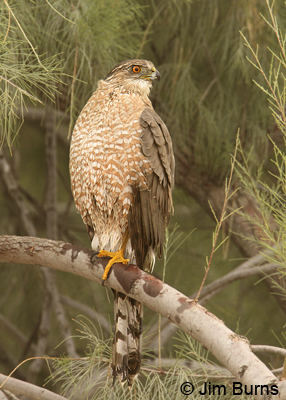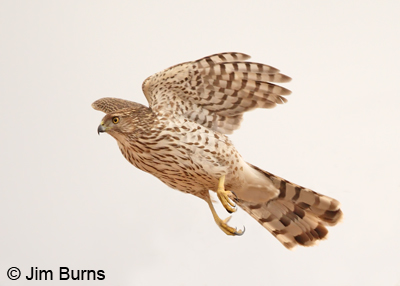Species Spotlight - Cooper's Hawk

Is there a killer loose in your neighborhood? Since the first of the year, I’ve spoken with three different people who were surprised by one in theirs. One thought it was “just” an American Kestrel, another excitedly thought he had a Prairie Falcon, but in both instances a blurry camera phone shot told a different story—Cooper’s Hawk. And, logically so, because Coops, though correctly reputed to be shy and reclusive, are the most commonly encountered raptor in the Valley . . . in winter. More on that qualifier in a moment, but first a few words about the species and its genus, Accipiter.
Accipiters are woodland raptors characterized by short, rounded wings for sudden bursts of speed, and long tails for maneuverability through forested areas. There are three accipiters in North America, all found in Arizona. Cooper’s Hawk, Accipiter cooperi, is the “middle” one, a crow-sized hawk larger than Sharp-shinned Hawk and smaller than Goshawk, its two congeners. “Accipiter” comes to us from the Latin ad, “after,” and capito, “take”. And yes, accipiters are killers, bird specialists who “take” mostly medium sized birds and some rodents. The species name honors William Cooper, a nineteenth century New York ornithologist.
Cooper’s in their preferred breeding habitat, low to mid-elevation riparian woodlands, can be hard to find as befits a bird of prey dependent upon stealth and surprise attack to survive. They nest throughout Arizona except in the low southwestern deserts, treeless grasslands, and the higher elevations of the White Mountains.
Nesting in Arizona occurs primarily between late March and early May. Nests are an agglomeration of sticks placed in the crotch of a deciduous tree and lined with bark. Nests may be used in successive years, but new nests are often built in the same territory and used alternately from year to year. The male is the primary nest builder, the female the primary incubator of an average brood of three to four eggs. Nest predation is by raccoons and Great Horned Owls.
Coops show the greatest reverse size dimorphism in the avian world, females one-third larger than males, but there is no size overlap between female Sharpies and male Cooper’s, nor between female Cooper’s and male Goshawks. Even so, beware of using size to distinguish between these three relatives, and beware even more so of using plumage characteristics to distinguish between Sharp-shinned and Coopers, nearly identical in all plumages.
The best field marks for perched Coops are the blocky, squared off head and the rounded tail tip (Sharp-shinned head is rounded, the tail squared off). On flying birds look for the Coop’s stiff, shallow wingbeats and straight-winged, large headed appearance (Sharpies wingbeats are deep and wristy, wings “hunched,” and the head appears small). Adults of either species are distinguished by horizontal rufous barring on the underparts and orange to red irises. Juvenile underparts are marked by vertical brown streaking, and will show a green to yellow iris.
Cooper’s Hawks are migratory, with the northern third of the continent’s population heading south for the winter and hanging out in urban areas where there are concentrations of city birds like pigeons and doves and many residential winter feeding stations. Coops may frequent one neighborhood for days or even weeks, surviving on the easy pickings before they head north at the end of this month. Typical Valley hotspots for Cooper’s Hawks in winter are the Gilbert Water Ranch, Papago Park, and the Tres Rios Wetlands. Or just ask a neighbor with bird feeders to alert you if they see a killer in their yard.